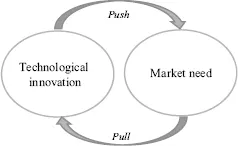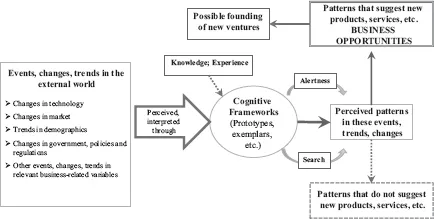![]()
CHAPTER 1
RECOGNIZING OPPORTUNITIES AND TESTING THE CONCEPT
At the heart of entrepreneurship, opportunity is the key word. Many people think of opportunity in different ways, but what is clear is that entrepreneurs are highly skilled at recognizing opportunities. In fact, entrepreneurs have an innate ability to recognize opportunities, assess them, and act on them (or chose not to). Simplistically, four questions are inherently involved: Is there a problem? How big is it? Is it worth pursuing? Am I capable of pursuing it? In this chapter, we look at the skills and processes needed to hone your skills at recognizing opportunity.
1.1 SOURCES OF DISCONTINUITY AND DISSATISFACTION
1.1.1 DISCONTINUITY AND DISSATISFACTION
Perhaps the hardest thing for an engineer to understand is that a beautiful piece of technology they have spent countless hours developing and testing, proving out exemplar performance and reliability, may be of no interest to anyone but themselves. This is a case of technology push, where a new technology or capability is developed, and the inventor looks for an application or user. This is reminiscent of the first Apple computer, where Steve Jobs and Steve Wosniak shopped around their new invention without a clear demand from customers saying “we need a personal computer.” Conversely, technology pull refers to the size of a known opportunity (or problem) attracting technology development to meet the need (Figure 1.1). The biotech industry fits this description well. Many cancer drugs are in development with billions of dollars invested because the demand for a solution to the problem (of specific cancers) is quantified, the lack of a solution is death, and the market is phenomenally huge in terms of dollars (billions). Genentech worldwide sales of Avastin, used to treat metastatic colon or rectal cancer in combination with a chemotherapy regimen, have totaled over $40 billion since U.S. Food and Drug Administration (FDA) approval and launch on the market in 2004.
Figure 1.1. Technology push and pull.
Technology push or pull can be successful, with the basic question changing in each case. In the case of technology push you are saying “here are the functions and features of my technology, now who has a need for these functions and features,” whereas for technology pull you are defining a need and seeking the technology with features that meet the need. In some cases the technology pull will drive specific research and development programs to initiate the creation of a new technology to meet the need. Interestingly, had Apple followed traditional corporate marketing logic at the time, they would have killed the project due to a complete lack of market (i.e., no known customer, therefore no demand, hence no product to develop and sell), versus their technology push of creating the market and the demand by introducing new functionality. Regardless of you choosing a path to push or pull technology, understanding sources of discontinuity and dissatisfaction in the market are paramount to recognizing opportunities.
For entrepreneurs, discontinuity refers to a break or disruption in the norm or pattern of behavior. These disruptions or changes offer a window of opportunity, as they change how things are currently done. These opportunities can be categorized by societal, technological, and/or market discontinuities (Table 1.1).
1.1.2 RECOGNIZING OPPORTUNITIES
Perhaps the greatest tool the entrepreneur can have is an ability to tune into dissatisfaction. This is an ability to recognize quickly that someone is expressing an opinion that may potentially be a market need. Whether it is in person, in print, or media, the successful entrepreneurial mind is constantly, even subconsciously, alert to phrases such as:
Table 1.1. Types of discontinuity and resulting opportunity
| Discontinuity/disruption | Opportunity |
| Population demographics | Elder care for U.S. baby boomers |
| Educational paradigms | Online university, self-paced asynchronous learning |
Societal | Sustainment | Food sourcing for increasing population |
| Government regulations | E-cigarettes |
| New knowledge | Photoelectric effect (leading to solar panels) |
Technological | Innovations | Solar panels |
| Disruptive technologies | Digital imaging (replacing film) |
| Location | Physical in new market, virtual in new markets |
Market | Access | Supply chain integration |
| Deregulation | Free trade agreements |
• I don’t like this
• This bugs me
• I wish I had…
• I hate…
• Wouldn’t it be nice if…
• This failed
• This doesn’t work
Recognizing these and then pursuing them with inquiry about “why?” can lead to identifying potential customers and markets for new products. Six key factors affect your ability to recognize opportunities, including prior knowledge, social capital, your personality, environmental conditions, your alertness, and your desire to perform a systematic search. Building your own entrepreneurial radar is a key activity you should undertake. Figure 1.2 shows a general model proposed for understanding the opportunity identification process. For successful entrepreneurs this may happen subconsciously as part of their persona, whereas new entrepreneurs may have to consciously think about which of these actions they are taking. Recognizing the opportunity and its timing can be critical for a successful venture launch.
Figure 1.2. The potential role of pattern recognition in opportunity recognition (adapted from Baron 2006).
For the entrepreneur, one person’s problems are the others’ opportunities. Problems can be defined as simplistic (one answer to a problem), deterministic (one formula produces one answer), random (different answers exist and can be identified), and indeterminate (many different answers are possible). Developing a disruptive or radical innovation typically requires solving problems whose complexity results in either random or indeterminate problems. Solving these types of problems requires creative thinking, scanning the environment for ideas and information, finding ways to process ideas and information, synthesizing ideas and information into potential solutions, and evaluating and selecting the appropriate solutions. To start the process categorizing your opportunities is important. Dorf and Byer (2004) suggest trying to categorize your opportunity area as one of the following:
1. Increasing value of product or service (performance, quality).
2. New applications of existing means or technologies (magnetic strip readers for hotel doors).
3. Creating mass markets (3-D printers for home use).
4. Customization for individuals (build to spec computers using common parts, car options).
5. Increase reach (insurance companies using web portals in addition to versus physical sales force).
6. Manage the supply chain (Toyota, Dell, Wal-Mart).
7. Convergence of change (digital assistant, camera, media player, phone all combined into one device; cable/fiber providers bundling phone, In...


